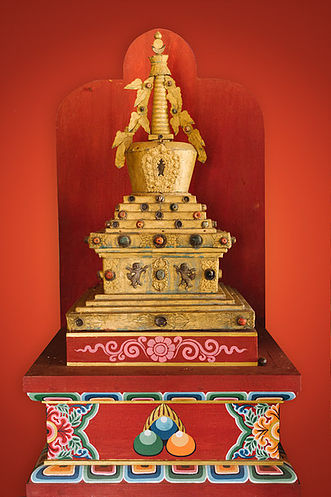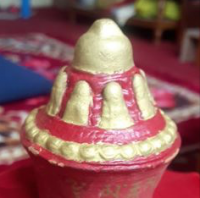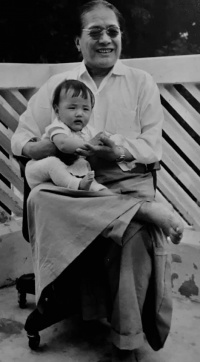Namgyal Drolma

Namgyal Drolma (Tib. རྣམ་རྒྱལ་སྒྲོལ་མ་, Wyl. rnam rgyal sgrol ma) (1887?-1960’s?)[1] was the mother of Dudjom Rinpoche and of Tulku Palden. Namgyal Drolma's family, originally from Bhutan, were lineal descendants of Ratna Lingpa. Later, the familya settled in Pemakö where Namgyal Drolma met Khengen Tulku, aka Tulku Jampal Norbu. She then resettled in Khorlo Dratsang, upper Pemakö, where she married Lama Könrab, a direct student of Dudjom Lingpa.
Birth, Family
In approximatively 18th-19th century, Namgyal Drolma’s family had emigrated from eastern Bhutan to Pemakö. Her family members were direct descendants of the fifteen-century tertön Ratna Lingpa, whose termas are widely practiced in all parts of Pemakö, as well as in many major monasteries following the Nyingma tradition.
Activity
Meeting her husband Tulku Jampal Norbu, aka Khengen Tulku
According to the oral stories recounted by Dudjom Rinpoche himself, his father Khengen Tulku and his mother Namgyal Drolma met in the following way[2]
- Tulku Jampal Norbu, aka Khengen Tulku, although not a monk, wasn’t married. He was living at his monastery of Khang Kheng [in Powo], and performing beneficial activities. Once again, a dakini, and also Gyalwa Phakpa Lha, told him to go to the Terkong Nang area, where he would meet a karmically connected dakini, establish a monastery, had a very special son who would benefit the dharma and sentient beings greatly.
- Following their instructions, Tulku Jampal Norbu eventually arrived there and found the area populated by about thirteen large families and fifteen or sixteen retinue families. Among the large families was one that had emigrated from eastern Bhutan and was descended from the great Nyingma tertön Ratna Lingpa. Tulku Jampal Norbu asked that family to host him, and with great joy and respect they agreed. This family had a young sixteen-year-old daughter named Namgyal Drolma. He slept with her that night and many beautiful signs and indications came. In the early morning he told the daughter’s parents, “I want to stay in this area and build a monastery near the mountain, but I will need your help. I would also like your daughter to be my wife.” The parents joyously agreed. They sought out a perfect location for the monastery and found a beautiful site about three miles from the village. In that area, however, there were no stones, and everyone said, “If the temple is not built of stone, it won’t last long.” The lama prayed to the Three Roots and especially to Guru Rinpoche, performed many ganachakras and made many offerings to the local land deities. He had auspicious dreams that night. Early in the morning, he told his students and dharma patrons, “Today I am going to reveal a treasury of stones, but I will need the assistance of a man named “Stone”. Everyone was trying to think of someone with that name. Someone remembered a very good craftsman from Powo named Dorje Drakpa, and there was general agreement that he must be the man. They located this man, and then all of them accompanied the teacher to the selected location where they did fire puja Jinsek and dharmapala offerings. Tulku Jampal Norbu said to Dorje Drakpa, “Dig in the dirt.” Dorje Drakpa struck with his pick, and when he did, many stones of different sizes emerged looking like they had been prepared by a mason. With them, they were able to complete the construction of the monastery”.
Giving birth to Dudjom Rinpoche
In 1904, Namgyal Drolma gave birth to her first son, Düdjom Rinpoche, amidst innumerable auspicious signs. After three years, many students of Dudjom Lingpa arrived in Pemakö, led by Gyurme Ngedön Wangpo. They recognized her son as the unmistaken immediate reincarnation of their master Dudjom Lingpa. He was given the name Dudjom Jigdrel Yeshe Dorje.
Giving birth to Tulku Palden
Later, Namgyal Drolma gave birth to a second son named Tulku Palden, who was recognized as the reincarnation of another great master named Gyalwa Phakpa Lha, the very same master who had requested Tulku Jampal Norbu to leave Powo for Pemakö to meet his prophesied consort.
Namgyal Drolma recalled a prophetic dream she had, saying, “In my dream I found two conches with the most beautiful color and shape, perfect in every way, only one was slightly bigger than the other. As I tried to blow each conch, the sound of the larger went in all directions, yet as I blew the second one, the sound did not go very far.” Clearly, the first conch represented Dudjom Rinpoche, whose enlightened activities have reached all directions, and the second one symbolized Tulku Palden, who did not live long enough to complete his Dharma activities.”[3]. According to Tulku Orgyen Phuntsok, ‘Namgyal Drolma was well-known as a Dakini in human form’.[4]
Marrying Lama Könrab
After the passing of her first husband Tulku Jampal Norbu, Namgyal Drolma married Lama Könrab, a direct student of Dudjom Lingpa who had come from Golok to Pemakö in search of the incarnation of his teacher. Lama Könrab was the main master of the dharma center Khorlo Dratsang. Namgyal Drolma and Lama Könrab's house was located just behind the Khorlo Dratsang dharma center. Khorlo Dratsang was not a monastery, but a Dharma center where people would come just to practice and did not have to permanently stay at this place. Pemakö people love that way of practicing. [5] Lama Könrab was the father of Chonyi Rinpoche, a main student of Dudjom Rinpoche, who married Semo Dechen Yudron.
Settling in Pemakö
Lopön Ogyan Tanzin Rinpoche is among the very few people alive who met Namgyal Drolma. He shared the following story[6],
- When I was six or seven years old, around 1958, I went with my mother to Pemakö. There, I met Namgyal Drolma. She was short, like Dudjom Rinpoche’s size, with white and long hair. At that time, she must have been approximatively sixty years old. Her hair was done nicely like the Pemakö women. Namgyal Drolma was a wonderful woman, so nice, and so beautiful.
- Namgyal Drolma owned many lands, larege enough to feed many people. The fields were so big that many people from many different areas and villages of Pemakö, like Tirkung and Géling villages, had to go there to help work on the fields. My mother helped Namgyal Drolma work in the farm. But because I was only six or seven years old, I did not have to work in the fields.
- When the fields were harvested, and in the New Year, we were invited for feasts. For the feasts, I always joined, with my mother. I went to Namgyal Drolma and Lama Könrab’s house, which was located just behind Khorlo Dratsang.
Family
With Tulku Jampal Norbu, Namgyal Drolma had two sons:
Final Years

Namgyal Drolma passed away in Upper Pemakö, before the political turmoil of the 1960s. During Namgyal Drolma’s cremation, many people saw an image of Vajravarahi in the flame.[7]
The sacred remains of Namgyal Drolma were first kept in Khorlo Dratsang, in upper Pemakö. But in 1959, due to the political turmoil in Tibet, the sangha members of Khorlo Dratsang, led by Togden Kunzang Longrol, relocated from Upper Pemakö to the safety of Lower Pemakö, in present day India, in Deden Tashi Chöling. At the same time, Namgyal Drolma's physical remains were transported with the same refugees to Pemakö, along with other sacred objects.
Despite many hardships, the sangha members finally arrived. Then, at the temple of Deden Tashi Chöling, Togden Kunzang Longdrol, they built the stupa containing Namgyal Drolma's relics.[8]The stupa has been enshrined in the temple of Deden Tashi Chöling ever since. Togden Kunzang Longdrol considered this reliquary stupa to be significantly relevant in the holy land of the Dakini Vajravarahi, and complimentary to the other sacred objects related to the Dudjom lineage that are housed in the temple.
According to Tulku Orgyen Phuntsok,[9]
- More importantly, the blessings of Namgyal Drolma, the dakini in human form, are accessible at this temple, to all who engage in the practice of the Wisdom Dakini, for generations to come. Since the creation of the stupa, on the 25th day of every lunar month, extensive Dakini tsok offerings have been performed, through either the sadhana of Tröma Nakmo (Dudjom)’s Chö, or Yeshe Tsogyal's Khandro Tuktik. Thus, the aspiration to be in a single mandala came true for all tantrika sangha members as they resumed their group practices in the temple under the direction of Tokden Kunzang Longdrol. Today, extensive tsog offerings are still made on every Dakini day, led by Lama Rigdzin Phuntsok, the yogis and yoginis in long-term retreat, and other practitioners, in the very temple holding the reliquary stupa of Namgyal Drolma. Many practitioners now view the opportunity to do dakini practice in the presence of the stupa as a great fortune.
Tulku Orgyen Phuntsok recounts how proud Pemakö people were and are nowadays of having those really cherished Dudjom Tersar relics, the stupas of Namgyal Drolma and of Gyurmé Ngédön Wangpo.[10]
After the passing of his mother, Dudjom Rinpoche made Tsa Tsas with her bone relics. The Tsa Tsas were consecrated by Dudjom Rinpoche, and are now kept in Zangdokpalri Monastery, in Kalimpong, India.
Reincarnation

According to Shenphen Dawa Rinpoche, "From the union of my sister Chimey Wangmo and Dasho Urgyen Wangchuk, Semo Lhanzey Wangmo was born. Even before she was born, Dudjom Rinpoche recognized one of his own grand-daughters, Semo Wangmo Lhanzey, as an incarnation of his mother Namgyal Drolma."[11]
Notes
- ↑ The calculation of Namgyal Drolma’s birth year as 1887 is approximate. Based on the story shared in Khenpo Tsewang Dongyal's Light of Fearless Indestructable Wisdom: The Life and Legacy of HH Dudjom Rinpoche (Snow Lion, 2008). When Tulku Jampal Norbu first met Namgyal Drolma, they slept together that same night and beautiful signs and indications appeared. According to the story, Namgyal Drolma was 16 years old at the time they met. Dudjom Rinpoche was born in 1904. According to this information, her birth could be 1887.
- ↑ Khenpo Tsewang Dongyal, Light of Fearless Indestructible Wisdom: The Life and Legacy of H. H. Dudjom Rinpoche, Snow Lion 2008, page 59-61.
- ↑ Presentation of Deden Tashi Chöling on pemakoddharmawheel.org
- ↑ Presentation of Deden Tashi Chöling on pemakoddharmawheel.org
- ↑ Private conversation with Lopön Ogyan Tanzin Rinpoche Rinpoche.
- ↑ Private conversation with Lopön Ogyan Tanzin Rinpoche Rinpoche.
- ↑ Private conversation with Tulku Orgyen Phuntsok.
- ↑ The photo of the stupa is shown on the top right of this page.
- ↑ Presentation of Deden Tashi Chöling on pemakoddharmawheel.org
- ↑ Private conversation with Tulku Orgyen Phuntsok.
- ↑ http://www.tersar.org/about-sangyum-rikzin-wangmo/ Text on Sangyum Rigdzin Wangmo